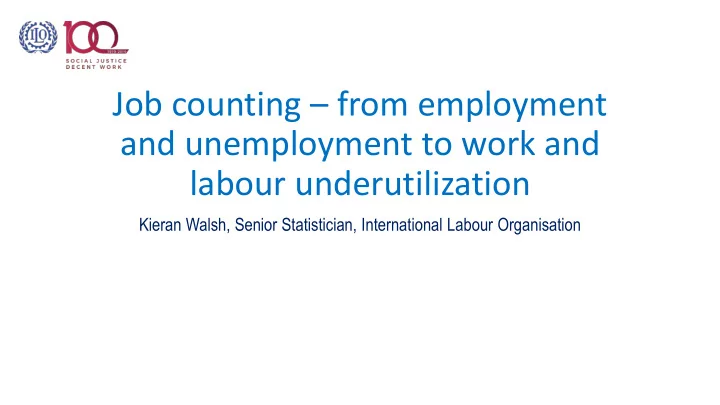

Job counting – from employment and unemployment to work and labour underutilization Kieran Walsh, Senior Statistician, International Labour Organisation
Limitations of statistics using 1982 standards • Employment covered both paid and unpaid work (in theory) • In practice countries adapted coverage to national context • Difficult to interpret international comparisons • Imperfect link to employment policy (plus gender bias etc). Employment to population ratio by country (ILOSTAT, latest year available) 90 % of Working age population 80 70 60 50 40 30 20 10 0 Source: ILOSTAT
Limitations of statistics using 1982 standards (2) • Unemployment insufficient to reflect all different situations of labour underutilization • Also not reacting as expected in face of crises • Need to develop wider set of indicators to supplement the unemployment rate • Based on country experiences (e.g. U1 to U6 in the US)
New Standards – 19th ICLS in 2013 • Employment is one form of work (work done for pay or profit) Wider definition of • Also own-use production work, volunteer work, ‘work’ with multiple unpaid trainee work forms of work • Recognition that people can be doing multiple forms of work in the same time period 4 proposed labour • Unemployed underutilization • Unemployed plus time related underemployed indicators (including • Unemployed plus ‘ potential labour force’ unemployment rate) • Composite rate including all components
Illustration: Old versus new standards Labour Market Estimates, Rwanda, Old and New Standards, 2017 5,000.0 4,668.4 4,500.0 4,000.0 3,590.3 3,372.1 3,500.0 3,011.6 3,000.0 000's 2,500.0 2,008.1 2,000.0 1,447.2 1,500.0 1,000.0 632.5 570.2 339.7 288.5 500.0 0.0 Employed Time-related Unemployed Not Economically Potential labour Subsistence underemployed Active force foodstuff producers Old Standards New Standards
Illustration: Old versus new standards – subsistence foodstuff producers Labour market status by participation in subsistence work, new standards, Rwanda 2017 3500 3000 2500 1,587.9 2000 000's 1500 1,195.1 386.9 1000 1423.7 500 1,060.4 256.2 729.8 376.4 0 Employed (through Unemployed Potential Labour Force Others outside the non-subsistence work) Labour Force Subsistence foodstuff producers Non-subsistence foodstuff producers
Illustration: Labour underutilization Composite indicator (LU4) ILO Department of Statistics and ITC-ILO Source: ILO calculations based on national data (2011)
10000 12000 14000 16000 18000 2000 4000 6000 8000 0 1994Q1 1994Q3 1995Q1 1995Q3 1996Q1 1996Q3 Potential Labour Force 1997Q1 United States of America - Labour Underutilization, 1994 to 2019 1997Q3 Labour Underutilization components Illustration: 1998Q1 1998Q3 1999Q1 1999Q3 2000Q1 2000Q3 2001Q1 2001Q3 2002Q1 2002Q3 2003Q1 2003Q3 2004Q1 Unemployment 2004Q3 2005Q1 2005Q3 2006Q1 2006Q3 2007Q1 2007Q3 2008Q1 2008Q3 2009Q1 2009Q3 Time Related Underemployment 2010Q1 2010Q3 2011Q1 2011Q3 2012Q1 2012Q3 2013Q1 2013Q3 2014Q1 2014Q3 2015Q1 2015Q3 2016Q1 2016Q3 2017Q1 2017Q3 2018Q1 2018Q3 2019Q1 2019Q3
Illustration: Labour Underutilization components Labour Underutilization - United States of America, 2008 to 2011 (Q12008=100) 250 200 150 100 50 0 Potential Labour Force Unemployment Time related underemployment
What next? • Mainstreaming of regular measurement and dissemination using the latest standards • Also expand our frameworks on characteristics of work people do • More meaningful description of work relationships, formality etc. • Particularly important as policies for formalisation are being counterbalanced by increasingly informal work arrangements (gig-economy) and various other phenomenon
Recommend
More recommend